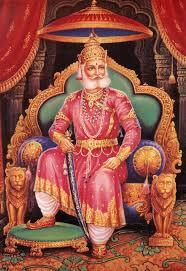
Maharaja Agrasen was a descendant of Lord Rama, who became a Vaishya on the advice of Goddess Mahalakshmi. He established a kingdom of Vaishyas (traders) in Northern India. He is the chief deity of the Agarwal community, which is a trader community. Maharaja Agrasen is less popular among other Hindu communities. The Government of India issued a postage stamp in his honor in 1976. The city of Agra is named after him.
Iconography:
Maharaja Agrasen is mainly depicted as an old man with a white beard. He is wearing royal clothes with golden ornaments and a golden crown. He wears a Tilaka on the center of his forehead.
The Story of Maharaja Agrasen:
Birth and Ascension to the Throne:
Maharaja Agrasen was born anywhere between 3082 BCE to 637 AD. One of the speculated dates of his birth is September 15, 3082 BCE. He was the son of King Vallabha and Queen Bhagwati Devi. He was born in the 15th (or 35th per Wikipedia) generation of Lord Rama and was the descendant of Kusha, the son of Lord Rama.
His father died during the Mahabharata War fighting for the Pandavas. Being the eldest son, Prince Agrasen ascended the throne. He was 15 years old at that time.
The Marriage of Maharaja Agrasen:
In his youth, he attended the Swamyamvara of Madhavi, the daughter of King Nagaraj. Madhavi was so beautiful that even the gods wished to marry her. Even Lord Indra attended the Swayamvara, but Madhavi chose Maharaja Agrasena as her husband and put the garland around his neck.
The Conflict with Indra:
Indra considered it as his insult and also became jealous. He decided to punish Agrasen. He stopped the rain in the kingdom of Maharaja Agrasen, which caused a great famine. Therefore, Maharaja Agrasen waged a war against Indra and was about to defeat his army. Then gods intervened and asked Sage Narada to mediate. Narada mediated peace between them.
Penance:
For the welfare of his subjects, Maharaja Agrasen started a severe penance to propitiate Lord Shiva, who advised him to worship Goddess Lakshmi. Therefore, he propitiated Goddess Lakshmi. She appeared before him and advised him to accept the Vaishya tradition. She asked her to establish a new kingdom and that she would bless his descendants with prosperity.
Establishment of Agroha Kingdom:
Maharaja Agrasen and his wife traveled extensively throughout India to choose the land for their new kingdom. At one place, they saw a few tiger cubs and wolves playing together. They considered it an auspicious sign and founded their kingdom at that location. This place is near Hisar in Haryana.
Benevolent Nature of Maharaja Agrasen:
Maharaja Agrasen performed 18 yajnas for the welfare of his subjects and divided his kingdom into 18 regions. During the 18th yajna, a horse that was brought to be sacrificed was trying to get away from the sacrificial altar. The king felt pity for him and let it go. After discussing with his ministers, he stopped the sacrifice of animals throughout his kingdom. As the animal sacrifice was not performed during the eighteenth yajna, it was considered incomplete. This yajna was being performed for Nangal gotra. Therefore, this gotra is considered a half-gotra in the Agrawal community. Hence, there are seventeen and a half gotras in the Agrawal community. The Agroha kingdom prospered very well under the leadership of King Agrasen.
Sanyas:
Maharaja Agrasen ruled for 108 years. In the later part of his life, he made his eldest son Vibhu the king of Agroha and retired from mundane life. He accepted Vanaprastha Ashrama and spent the rest of his life attaining moksha.
The Decline of the Agroha Kingdom:
The neighboring states got jealous of Agroha’s prosperity and frequently attacked it. This caused the weakening of Agroha. Once a huge fire engulfed the kingdom. Therefore, the citizens left the city and dispersed into different parts of India.
Maharaja Agrasen Ki Baoli:
It is a 60-meter long and 15-meter wide step-well in New Delhi in India. It is believed to be built by Maharaja Agrasen. The place is famous for its architecture as well as its mysteries. It is said that the well contained black water that used to encourage people to commit suicide at this place, but nowadays, the well has dried, and there is no water in it.
Agrawal Community:
According to a survey, the Agrawal community contributes more than 25% of the country’s total income tax. Of the total social and religious donations, 62% share belongs to them. Out of a total of 16,000 gaushalas, 12,000 are run by the Agravanshi Vaishya community. 25% of India’s development is contributed by the descendants of Maharaja Agrasen, whose population is only 1% of the country’s population.
Agrawal Gotras:
There are a total of seventeen and a half gotras in the Agrawal community. Their names are Bansal, Goyal, Kucchal, Kansal, Bindal, Dharan, Singhal, Jindal, Mittal, Tingal, Tayal, Garg, Bhandal, Nangal, Mangal, Airan, Madhukul, Goyan.
The Nangal gotra is considered to be a half gotra.
Maharaja Agrasen Jayanti:
The birth anniversary of Maharaja Agrasen is celebrated as Agrasen Jayanti by the Vaishya community. It is observed on the fourth day of the Ashwin month of the Hindu calendar.
Devotees make special preparations to make Maharaja Agrasen Jayanti special. The birth anniversary of divine leader Maharaja Agrasen is celebrated with a colorful procession and various cultural programs that are conducted throughout the day at different places in India. The Jayanti is celebrated by the Vaishya community with full religious devotion. Agrasena Jayanti is celebrated across India among Agrahari, Agrawal, and Jain. On this day, descendants of Agrasena busy themselves with social welfare activities. Free medical camps, food distribution, and several cultural functions and programs are taken up to spread the message of equality and brotherhood. They honor Agrasen for his ideals in life and try to follow in his footsteps.